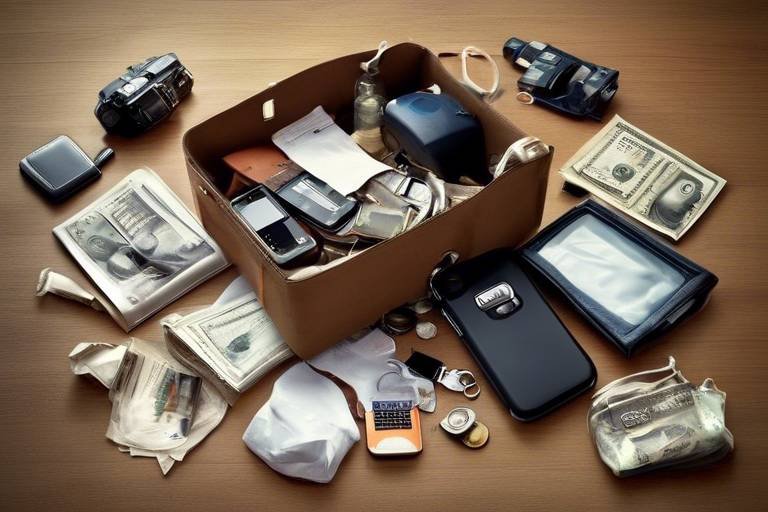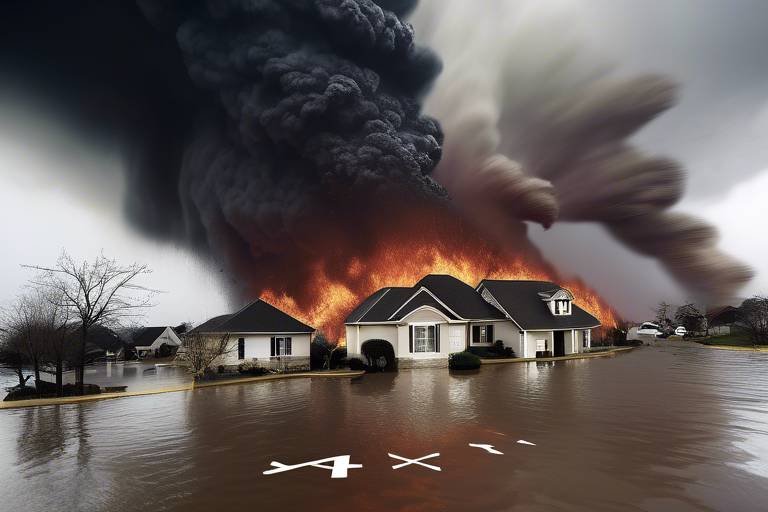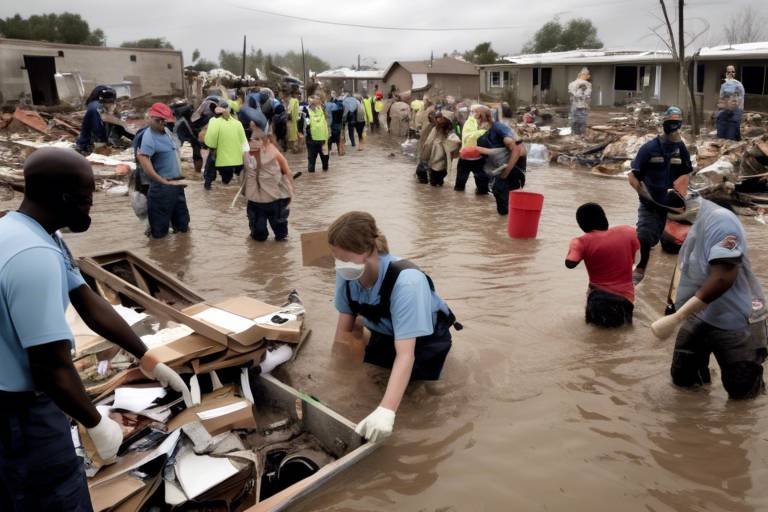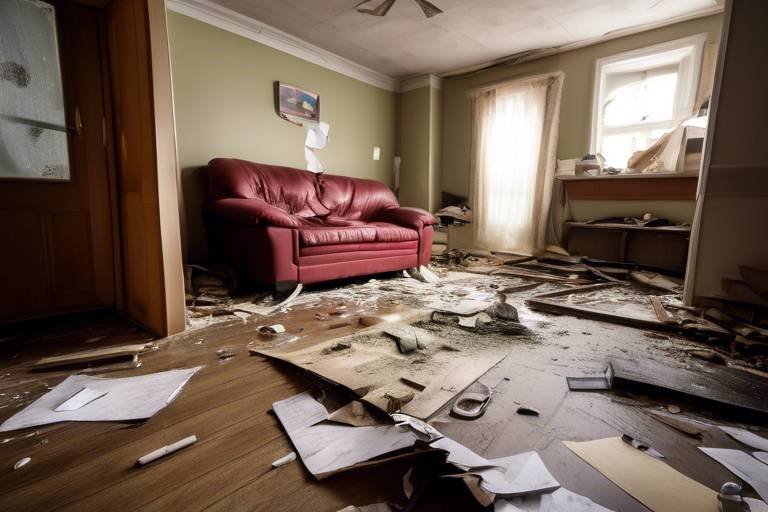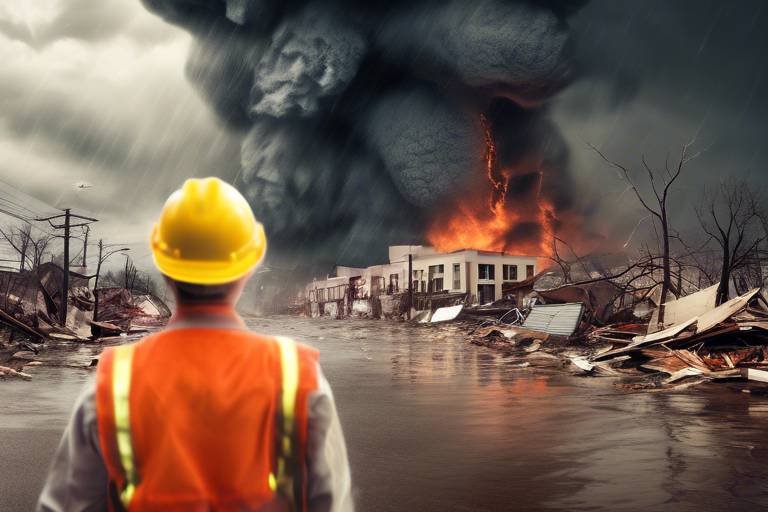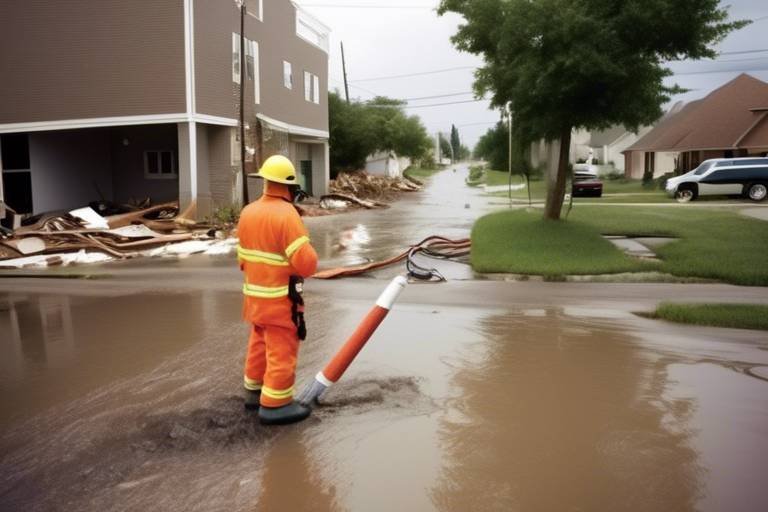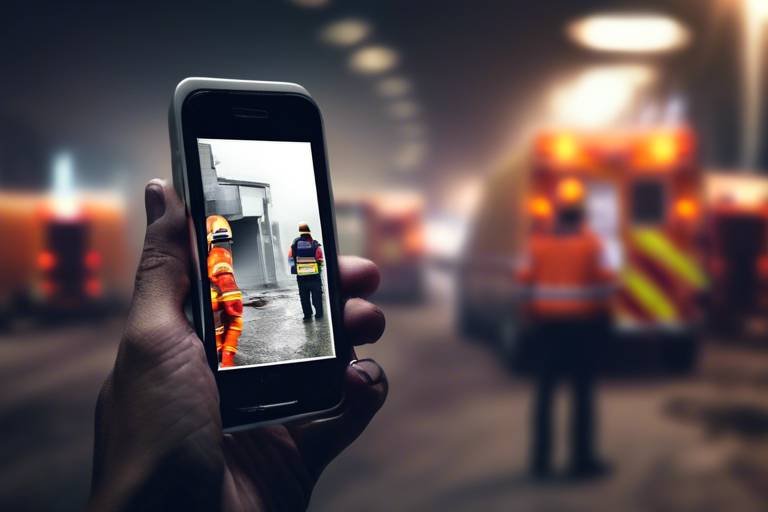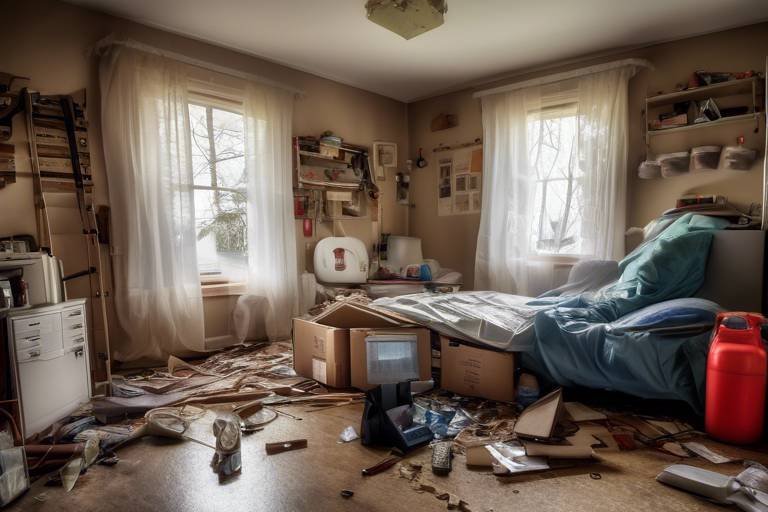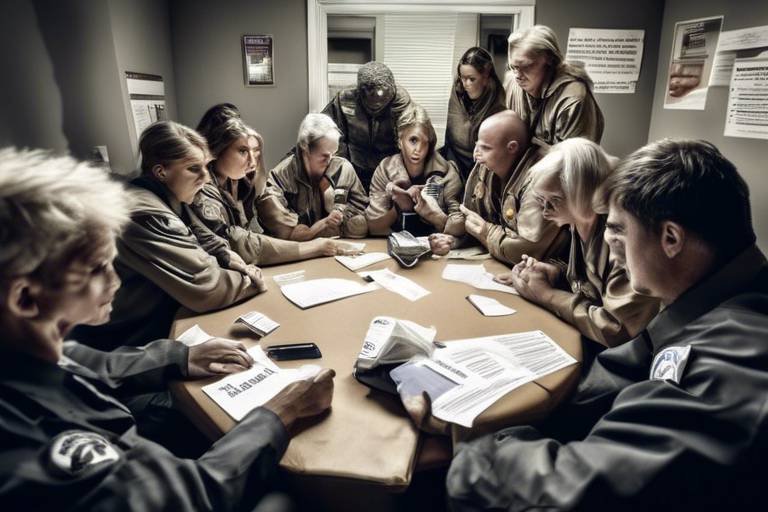Guidance to Protect Your Property & Assets in an Emergency
Emergencies can strike without warning, leaving you feeling overwhelmed and unprepared. Whether it's a natural disaster like a hurricane or an unexpected event such as a burglary, the impact on your property and assets can be devastating. This article provides essential strategies and tips for safeguarding your property and assets during emergencies, ensuring you are prepared for various situations that may arise unexpectedly. Imagine your home as a fortress; without the right defenses in place, it becomes vulnerable to the chaos outside. By the end of this guide, you'll have a clear understanding of how to bolster your defenses and protect what matters most.
Emergency preparedness is more than just a buzzword; it's a crucial mindset that involves planning and taking proactive measures to protect your assets. Think of it as a safety net that catches you when life throws you a curveball. Being prepared means you have a strategy in place, which can significantly reduce panic and confusion during a crisis. Key components of an effective emergency plan include risk assessment, resource allocation, and communication strategies. By being proactive, you ensure not only your safety but also the security of your belongings. Remember, the more prepared you are, the less likely you are to feel the sting of unexpected events.
Identifying potential risks to your property is crucial for effective emergency planning. Every region has its unique set of vulnerabilities, whether it's floods in a low-lying area or wildfires in a dry climate. Start by evaluating your surroundings and considering the specific threats you may face. Ask yourself questions like, "What natural disasters are common in my area?" or "Are there crime rates that I should be aware of?" Prioritizing actions based on these risks can help you focus your efforts where they are needed most. For instance, if you live in a flood-prone area, investing in waterproofing might be a priority. By understanding your risks, you can devise a tailored plan that addresses your specific needs.
An effective emergency plan outlines the steps to take during a crisis, acting as your roadmap when the unexpected occurs. Start by defining clear roles for each member of your household. Who will grab the emergency kit? Who will check on neighbors? Next, outline the specific actions to take for different scenarios, such as evacuation routes for natural disasters or procedures for securing your home during a break-in. It's essential to practice your plan regularly, ensuring everyone knows what to do when the time comes. Consider including a communication strategy, such as a group chat for family members, to keep everyone informed. Remember, a well-thought-out plan can be the difference between chaos and calm.
Physical security measures can deter damage to your property, acting as the first line of defense against both natural disasters and break-ins. Start by fortifying doors and windows; consider installing deadbolts and security bars for added protection. Reinforce your roof and walls to withstand severe weather conditions. Additionally, investing in security cameras and alarm systems can provide peace of mind. Don't forget about your outdoor space—trimming trees and securing loose items can prevent them from becoming projectiles during a storm. Your home should be a sanctuary, and with the right precautions, you can ensure it remains safe and sound.
Proper insurance coverage is vital for asset protection. It's not just about having insurance; it's about having the right kind of coverage that meets your specific needs. Start by evaluating the types of insurance policies available, such as homeowners, renters, and flood insurance. Each type covers different aspects of your property and belongings. For example, standard homeowners insurance may not cover flood damage, so it’s essential to read the fine print. When choosing the right coverage, consider factors like the value of your assets, potential risks in your area, and any additional coverage you may need. Remember, a good insurance policy can be your safety net when disaster strikes.
Having the right supplies on hand can make a significant difference during emergencies. An emergency kit should be a staple in every household, packed with essentials that can sustain you and your family during a crisis. Key items to include are:
- Non-perishable food and water
- First aid supplies
- Flashlights and batteries
- Multi-tools or Swiss Army knives
- Important documents in a waterproof container
Additionally, consider including personal items like medications and pet supplies. Regularly check and update your emergency kit to ensure everything is in working order and not expired. Being well-prepared can give you peace of mind, knowing that you have the resources to handle whatever comes your way.
Local resources can be invaluable during emergencies. Often, community organizations and support systems are in place to assist residents in times of crisis. Familiarize yourself with local emergency services, shelters, and volunteer organizations that can provide help when needed. Joining community preparedness groups can also offer additional support and resources. Think of your community as an extended family; during tough times, it’s essential to lean on one another for assistance and guidance. By building these connections, you not only protect your property but also foster a sense of unity and resilience.
After an emergency, recovery is crucial for restoring your property and peace of mind. Start by assessing the damage—take photos and document everything for insurance purposes. Filing insurance claims can be a daunting task, but having thorough documentation will make the process smoother. Begin the rebuilding process as soon as possible, prioritizing repairs that will prevent further damage. Remember, recovery takes time, but with a solid plan and the right support, you can restore your property and emerge stronger than before.
Q: What should I include in my emergency kit?
A: Your emergency kit should include non-perishable food, water, first aid supplies, flashlights, batteries, and important documents in a waterproof container.
Q: How can I assess risks specific to my area?
A: Research local hazards, such as natural disasters or crime rates, and consider consulting local emergency management agencies for guidance.
Q: What type of insurance do I need?
A: It depends on your specific needs. Homeowners insurance covers your home and belongings, while additional policies like flood or earthquake insurance may be necessary based on your location.
Q: How often should I update my emergency plan?
A: Review and update your emergency plan at least once a year or whenever there are significant changes in your household or community.

Understanding Emergency Preparedness
Emergency preparedness is essentially the art of being ready for the unexpected. Think of it as your safety net, woven with care and foresight, designed to catch you when life throws a curveball. Whether it's a natural disaster like a hurricane or an unforeseen crisis such as a break-in, having a solid plan in place can mean the difference between chaos and calm. But what does it really mean to be prepared? It starts with understanding the potential threats you might face and taking proactive steps to mitigate those risks.
At its core, emergency preparedness involves a few key components that work together like the gears in a well-oiled machine. First, you need to identify the specific risks that could impact your property and assets. This might include environmental factors like floods, earthquakes, or wildfires, as well as human-made threats such as theft or vandalism. Once you’ve identified these risks, the next step is to develop a comprehensive plan that addresses each scenario. This plan should not only outline what to do in an emergency but also detail how to protect your assets and keep your loved ones safe.
Moreover, being prepared isn't just about having a plan; it's also about cultivating a mindset of readiness. This means regularly reviewing and updating your emergency plan, ensuring that all family members are aware of their roles, and practicing drills to make sure everyone knows what to do when the time comes. Just like a fire drill at school, these practices can help reduce panic and confusion in a real emergency.
In addition, consider creating an emergency kit filled with essential supplies. This kit should be easily accessible and include items like water, non-perishable food, first aid supplies, and flashlights. The goal is to have everything you might need in one place, ready to go at a moment’s notice. Remember, in the chaos of an emergency, every second counts, and having your supplies organized can save precious time.
Ultimately, understanding emergency preparedness is about taking control of the unpredictable. By planning ahead, assessing your risks, and creating a culture of readiness within your household, you can significantly enhance your safety and protect your valuables. So, ask yourself: Are you ready for whatever life might throw your way?

Assessing Your Risks
Assessing your risks is like taking a magnifying glass to your surroundings; it allows you to see potential vulnerabilities that could threaten your property and assets. Every neighborhood has its unique set of risks, whether they stem from natural disasters like floods and hurricanes or human-made threats such as burglary or vandalism. By understanding these risks, you can prioritize your actions and effectively safeguard what matters most to you.
Start by evaluating the specific dangers that are prevalent in your area. For instance, if you live in a region prone to earthquakes, it’s essential to consider how well your home can withstand such seismic activity. On the other hand, if your community frequently experiences severe storms, you might need to focus on flood-proofing your property. Here are some key factors to consider when assessing your risks:
- Natural Disasters: Identify the types of natural disasters common in your area, such as wildfires, tornadoes, or flooding.
- Crime Rates: Research local crime statistics to understand the likelihood of break-ins or vandalism.
- Structural Vulnerabilities: Examine your home’s structure for weaknesses, such as aging roofs or unsecured windows.
- Proximity to Hazards: Consider your location in relation to potential hazards, like industrial sites or flood zones.
Once you have a clear picture of the risks, it’s time to prioritize them. Not all threats are created equal; some may pose a more immediate danger than others. For example, if you live in a flood zone and your home is not adequately elevated, this risk should be at the top of your list. Conversely, while crime is a concern, it may not be as pressing if your neighborhood has a low crime rate. By prioritizing your risks, you can allocate your resources effectively, ensuring that you address the most pressing threats first.
Additionally, consider conducting a risk assessment survey to evaluate your property. This can involve walking through your home and yard, looking for potential hazards, and taking notes on what needs to be improved. Engaging with local community resources can also provide insights into common risks and effective mitigation strategies. Remember, being proactive is key; the earlier you identify and address potential risks, the better prepared you'll be when an emergency strikes.
In summary, assessing your risks is an ongoing process that requires vigilance and adaptation. As your environment changes or as new threats emerge, revisit your risk assessment regularly. This proactive approach not only protects your property and assets but also gives you peace of mind, knowing that you are prepared for whatever life throws your way.
Q: How often should I reassess my risks?
A: It's advisable to reassess your risks at least once a year or after any significant changes in your environment or circumstances, such as moving to a new area or experiencing a natural disaster.
Q: What should I do if I identify a significant risk?
A: If you identify a significant risk, prioritize it in your emergency planning and take immediate action to mitigate it, whether through physical improvements, insurance coverage, or creating a contingency plan.
Q: Can I get professional help with risk assessment?
A: Yes, many companies specialize in risk assessment and can provide a thorough evaluation of your property and recommendations for improving your safety.

Creating an Emergency Plan
When it comes to emergencies, having a solid plan can be the difference between chaos and calm. Think of your emergency plan as a roadmap that guides you through uncertain times—like having a GPS when you're lost in the woods. It’s not just about knowing what to do; it’s about being prepared for the unexpected. So, how do you create this vital plan? Let’s break it down together.
First and foremost, you need to identify the types of emergencies that are most likely to affect you. Are you in an area prone to hurricanes, earthquakes, or floods? Understanding the specific threats you face is crucial. Once you've pinpointed these risks, you can tailor your emergency plan accordingly. For instance, if you live in a flood zone, your plan should prioritize evacuation routes and securing your property against rising waters. On the other hand, if wildfires are a concern, having a clear exit strategy and knowing where to find safe zones is essential.
Next, consider the people involved in your plan. This includes not only your immediate family but also pets, extended family, and even neighbors who may need assistance. Make sure everyone knows their roles and responsibilities in an emergency. For example, designate someone as the family communicator who will keep in touch with loved ones during a crisis. This person can also help coordinate where to meet if you get separated. It's like having a designated driver; it just makes sense!
Another critical component of your emergency plan is communication. In today's world, we're used to instant contact, but during an emergency, phone lines can get jammed, and power outages can disrupt communication. Consider establishing a group chat or using walkie-talkies if cell service is unreliable. Also, make sure everyone knows how to reach each other, whether that's through social media, email, or even a simple meet-up spot. This way, you can keep the lines of communication open, even when the world around you feels chaotic.
Don’t forget to include practical details in your plan. Create a list of emergency contacts, including local authorities, hospitals, and family members. You might want to keep this list both digitally and in a physical format, such as on the fridge or in your wallet. Additionally, think about the supplies you'll need during an emergency, such as food, water, medications, and first-aid kits. It's wise to have these items easily accessible, so you’re not scrambling when time is of the essence.
Finally, practice makes perfect! Regularly review and rehearse your emergency plan with everyone involved. This could be as simple as a family meeting or a full-blown drill. The more familiar everyone is with the plan, the more confident you’ll feel when an actual emergency arises. Just like a fire drill at school, practicing your plan can help alleviate fear and uncertainty when the real thing happens.
In summary, creating an emergency plan is about preparation and reassurance. By identifying risks, establishing clear communication, and practicing your plan, you’re not just protecting your property—you’re also safeguarding your peace of mind. So take the time to sit down and map it all out. You’ll be glad you did when the unexpected comes knocking at your door.
- What should I include in my emergency kit? Your emergency kit should include essentials like water, non-perishable food, a flashlight, batteries, a first-aid kit, medications, and important documents.
- How often should I review my emergency plan? It's advisable to review your emergency plan at least once a year or whenever there are significant changes in your household or community.
- What is the best way to communicate during an emergency? Establish a plan for communication that includes multiple methods, such as texting, social media, or meeting at a designated location.

Securing Your Home
When it comes to protecting your home, think of it as building a fortress around your most cherished possessions and loved ones. isn’t just about locking doors; it’s a comprehensive approach that combines physical security measures, technology, and a little bit of common sense. The goal? To create a safe haven that deters intruders and minimizes damage from natural disasters.
First, let’s talk about the basics. Start by reinforcing your doors and windows. These entry points are the most vulnerable parts of your home. Consider installing deadbolt locks on all exterior doors, and don’t forget about sliding glass doors. A simple yet effective solution is to place a wooden dowel or a security bar in the track to prevent them from being forced open. For windows, adding locks that require a key can significantly enhance security.
Now, let’s step it up a notch. Investing in a home security system can be a game-changer. Many modern systems come equipped with features like motion detectors, surveillance cameras, and even smart home integration. Imagine being able to monitor your home from your smartphone while you’re away! This not only provides peace of mind but also acts as a deterrent to would-be intruders. According to studies, homes with security systems are less likely to be targeted by burglars.
But it’s not just about high-tech solutions. Sometimes, the simplest measures can be the most effective. For instance, landscaping plays a crucial role in home security. Keep bushes and trees trimmed to eliminate hiding spots for intruders. Additionally, consider planting thorny bushes under windows; they act as a natural barrier. Lighting is another key factor. Install motion-activated lights around your property to illuminate dark areas, making it less inviting for anyone with ill intentions.
In the unfortunate event of a natural disaster, securing your home means being prepared for the worst. Consider investing in storm shutters or impact-resistant windows if you live in an area prone to hurricanes or severe storms. These features can protect your home from flying debris and minimize damage. Moreover, securing heavy furniture and appliances to the walls can prevent them from toppling over during an earthquake.
Finally, let’s not forget the importance of community awareness. Get to know your neighbors and establish a neighborhood watch program. When everyone is looking out for one another, it creates a safer environment. Plus, sharing tips and resources can significantly enhance your collective home security. Remember, a well-secured home is a happy home, and taking these proactive steps can make all the difference.
Q: What are the most important security features to have in a home?
A: The most important features include deadbolt locks, a home security system, motion-sensor lights, and secure windows. Don’t underestimate the power of good landscaping and community awareness!
Q: How can I secure my home without breaking the bank?
A: There are plenty of cost-effective measures you can take, such as reinforcing doors, adding locks to windows, and improving outdoor lighting. Even simple changes like trimming bushes can enhance your home’s security.
Q: Are home security systems worth the investment?
A: Yes! Home security systems not only provide peace of mind but also deter crime. Many insurance companies offer discounts for homes with security systems, making it a financially savvy choice.

Insurance Considerations
When it comes to safeguarding your property and assets during emergencies, insurance plays a pivotal role. It's not just a safety net; it's a crucial component of your overall emergency preparedness strategy. Imagine being caught in a storm, your home sustaining damage, and realizing that your insurance policy doesn’t cover the losses. The thought alone can send chills down your spine! Therefore, understanding the types of insurance available and ensuring you have the right coverage is essential.
First, let’s break down the types of insurance you might consider:
- Homeowners Insurance: This is the most common type of insurance that protects your home and personal property against various risks, including fire, theft, and certain natural disasters.
- Renters Insurance: If you’re renting, this type of insurance covers your belongings against similar risks, ensuring that you won’t be left in the lurch if something unexpected happens.
- Flood Insurance: Standard homeowners insurance usually doesn’t cover flood damage. If you live in a flood-prone area, purchasing a separate flood insurance policy is a wise decision.
- Earthquake Insurance: Similar to flood insurance, this is often an add-on or separate policy to protect against earthquake damage, which can be devastating.
- Umbrella Insurance: This provides additional liability coverage beyond what your other policies offer, giving you peace of mind in case of lawsuits or major claims.
Now, understanding what these policies cover is just as important as having them. For instance, homeowners insurance typically covers the structure of your home, personal belongings, and liability protection. However, it may not cover certain types of damage, such as that caused by earthquakes or floods. That's where additional policies come into play. It’s crucial to read the fine print and know exactly what risks you are protected against.
When selecting the right coverage, consider the following factors:
- Location: Your geographic area plays a huge role in what types of insurance you need. Are you in a hurricane zone? A floodplain? Understanding local risks can guide your insurance choices.
- Value of Your Assets: Take a detailed inventory of your belongings. Knowing their value helps you choose coverage limits that adequately protect your investments.
- Deductibles: Higher deductibles often mean lower premiums, but you need to be prepared to pay more out of pocket in the event of a claim. Balance your budget with your risk tolerance.
Lastly, don't forget to review your policies regularly. Life changes—new purchases, renovations, or even changes in family status—can affect your insurance needs. It’s a good practice to sit down once a year and reassess your coverage. This way, you can ensure you’re not underinsured and that your policy accurately reflects your current situation.
In summary, insurance is a key player in protecting your property and assets during emergencies. By understanding the different types of insurance available, knowing what they cover, and regularly reviewing your policies, you can secure your peace of mind and safeguard your future.
Q: What should I do if I have a claim to file?
A: Contact your insurance company as soon as possible to report the claim. They will guide you through the process and inform you about the necessary documentation.
Q: How can I ensure my home is adequately insured?
A: Conduct a thorough inventory of your possessions, assess the value of your home, and consult with an insurance agent to determine the appropriate coverage.
Q: Are there discounts available for bundling insurance policies?
A: Yes! Many insurance companies offer discounts if you bundle multiple policies, such as homeowners and auto insurance, so be sure to ask about these options.
Q: How often should I review my insurance policy?
A: It’s recommended to review your insurance policy at least once a year or after significant life changes, such as moving, renovations, or major purchases.

Emergency Supplies and Equipment
When it comes to emergencies, having the right supplies and equipment at your fingertips can mean the difference between chaos and calm. Think of your emergency kit as your lifeline during a crisis; it's your personal toolkit designed to help you navigate through the storm. So, what should you pack in this essential kit? Here are some must-have items you shouldn’t overlook:
- Water: At least one gallon per person per day for at least three days, for drinking and sanitation. Water is your most important resource, so ensure you have enough.
- Non-perishable food: Stock up on at least a three-day supply of food that requires no cooking or refrigeration. Think energy bars, canned goods, and dried fruits.
- Flashlight: Power outages are common during emergencies, so a flashlight is crucial. Don't forget extra batteries!
- First aid kit: This should include bandages, antiseptics, pain relievers, and any personal medications you might need.
- Multi-tool or Swiss Army knife: A versatile tool can be invaluable for various tasks, from opening cans to making repairs.
- Whistle: In case you need to signal for help, a whistle can carry much farther than your voice.
- Dust masks: These can help filter contaminated air and protect you from breathing in harmful particles.
- Local maps: GPS might fail during emergencies, so having a physical map can guide you to safety.
But remember, simply having these items isn't enough. You need to regularly check and update your emergency supplies to ensure everything is in working order and hasn’t expired. It's like maintaining a car; if you don’t check the oil, you might find yourself stranded. Additionally, consider the specific needs of your family. If you have infants, elderly members, or pets, you’ll want to include items tailored to their needs, such as baby formula, pet food, or medications.
Another critical aspect of your emergency supplies is organization. Use clear, durable containers to store your items, and label everything clearly. In a panic, the last thing you want is to fumble around trying to find a band-aid or flashlight. Keep your emergency kit in a designated spot that all family members know about. Regular drills can help familiarize everyone with the location and contents, ensuring that when disaster strikes, you can act swiftly and confidently.
Lastly, don’t forget about communication. Having a battery-operated or hand-crank radio can keep you informed about weather updates and emergency instructions. Pair this with a list of emergency contacts and a plan for how you will communicate with family members in different locations. This way, you're not only prepared for the immediate crisis but also equipped to stay connected when it matters most.

Community Resources and Support
When emergencies strike, the importance of community resources and support cannot be overstated. Imagine facing a crisis alone—it's daunting, right? But what if you had a network of local organizations and neighbors to help you navigate through the chaos? Community resources provide a safety net, ensuring that you're not just left to fend for yourself when the unexpected happens. From local government agencies to non-profit organizations, these resources can offer crucial assistance in times of need.
First and foremost, local government agencies often have emergency management programs designed to coordinate disaster response efforts. These agencies can provide vital information on evacuation routes, shelter locations, and emergency services. For instance, during a natural disaster, they may set up community centers where residents can find temporary shelter and access food and medical supplies. It's essential to familiarize yourself with these agencies before an emergency occurs, so you know where to turn for help.
In addition to government support, many non-profit organizations play a significant role in community resilience. Organizations like the Red Cross and local food banks are often at the forefront of disaster relief efforts. They provide not only immediate assistance but also long-term recovery support. For example, after a flood, these organizations may offer financial assistance, counseling services, and even help with rebuilding efforts. Knowing how to contact these organizations and what services they provide can make a world of difference in your recovery process.
Moreover, don't underestimate the power of your neighbors. In times of crisis, community bonds can be incredibly strong. Forming a neighborhood watch or support group can create a network of individuals who are ready to help each other when disaster strikes. Whether it’s sharing resources like generators, food, or simply offering emotional support, having a close-knit community can lighten the burden during tough times. Be proactive—organize community meetings to discuss emergency plans and share contact information, ensuring everyone knows who to reach out to in an emergency.
Lastly, consider utilizing social media and local online forums to stay updated on community resources. Many neighborhoods have Facebook groups or websites where residents share information about local events, resources, and support systems. These platforms can be invaluable for quick communication during emergencies, allowing you to stay informed about what’s happening in your area. Remember, being connected to your community can significantly enhance your ability to respond to emergencies effectively.
In summary, community resources and support systems are your allies in times of crisis. By understanding what’s available and building relationships within your community, you can create a robust safety net that not only protects your property and assets but also fosters a sense of belonging and resilience. So, take the time to reach out, connect, and prepare together—because when the storm hits, it’s better to weather it as a team.
- What types of community resources are available during emergencies?
Community resources can include local government agencies, non-profit organizations, shelters, food banks, and neighborhood support groups. - How can I find out about local emergency services?
Check your local government’s website, social media pages, or community bulletin boards for information on emergency services and resources. - What should I do if I need assistance during an emergency?
Reach out to local emergency services or community organizations for immediate support. Don’t hesitate to ask neighbors for help as well. - How can I prepare my community for emergencies?
Organize community meetings to discuss emergency plans, share resources, and establish a communication network among neighbors.

Post-Emergency Recovery Steps
After the chaos of an emergency subsides, the journey to recovery begins. It’s like waking up from a nightmare—initially disoriented, but you must quickly regain your footing. The first thing to remember is that patience and organization are your best friends during this time. Assessing the damage to your property is crucial, as it will guide your next steps. You might feel overwhelmed, but taking a systematic approach can make the process smoother.
Start by conducting a thorough inspection of your property. Look for visible signs of damage, such as broken windows, roof leaks, or structural issues. Document everything with photographs; these will be invaluable when filing insurance claims. Remember, your insurance provider will likely require proof of damage, so the more evidence you have, the better. It's like building a case—every little detail counts!
Once you’ve assessed the damage, it’s time to contact your insurance company. This is where your earlier documentation comes into play. When you call, be ready to provide a detailed account of the damages and any temporary repairs you’ve made to prevent further loss. Keep a record of your communications with the insurance adjuster, including dates, names, and what was discussed. This meticulousness can save you a lot of headaches later on.
In the aftermath of an emergency, you may also need to consider temporary housing if your home is uninhabitable. This can be a daunting prospect, but many insurance policies cover additional living expenses. Check your policy details to understand your options. If you find yourself needing to relocate, make sure to keep receipts for any expenses incurred, as these may be reimbursable.
As you navigate through the recovery process, don’t forget about community resources. Local organizations often provide support, whether it’s financial assistance, temporary shelter, or even emotional support. Reach out to community centers, churches, or local charities; they can be a lifeline during tough times.
Lastly, once the immediate recovery steps are taken care of, it’s time to think about rebuilding and improving. This is an opportunity to not only restore your property but also to enhance its resilience against future emergencies. Consider investing in better materials or security systems. Reflect on the lessons learned and use them to fortify your home, making it a safer haven for you and your loved ones.
- What should I do first after an emergency? Start by assessing the damage and documenting it with photos.
- How do I file an insurance claim? Contact your insurance company, provide detailed accounts of the damages, and submit your documentation.
- Are community resources available for recovery? Yes, local organizations can provide assistance, including financial help and temporary shelter.
- How can I prevent future emergencies? Consider investing in better materials and security systems to enhance your property’s resilience.
Frequently Asked Questions
- What is emergency preparedness?
Emergency preparedness is the process of planning and taking proactive steps to protect your property and assets during unexpected situations. It involves understanding potential risks, creating a comprehensive plan, and having the necessary supplies on hand to respond effectively.
- How can I assess the risks to my property?
Assessing risks involves evaluating your location and identifying potential threats such as natural disasters, crime, or other emergencies. You can create a risk profile by considering factors like your area's history of events, the vulnerability of your home, and the types of emergencies that are most likely to occur.
- What should be included in my emergency plan?
Your emergency plan should outline specific actions to take during various crises. This includes evacuation routes, communication plans, designated meeting points for family members, and a checklist of essential supplies. Tailor your plan to address the unique risks you face in your area.
- How can I secure my home against emergencies?
To secure your home, consider reinforcing doors and windows, installing security systems, and maintaining your property. Simple actions like securing outdoor items and ensuring smoke detectors are functional can also make a significant difference in protecting your home during emergencies.
- What types of insurance should I consider?
It’s essential to have adequate insurance coverage to protect your assets. Homeowners insurance, flood insurance, and renters insurance are common options. Review your policies to ensure they cover the specific risks you face and adjust your coverage as needed.
- What emergency supplies should I have on hand?
Your emergency kit should include essentials like water, non-perishable food, first-aid supplies, flashlights, batteries, and important documents. Regularly check and update your kit to ensure everything is in working order and not expired.
- How can community resources help during emergencies?
Local community organizations can provide critical support during emergencies, such as shelters, food banks, and recovery services. Familiarize yourself with these resources and keep their contact information handy to ensure you have access to assistance when needed.
- What steps should I take after an emergency?
After an emergency, assess the damage to your property, document it thoroughly with photos, and file any necessary insurance claims. Begin the recovery process by contacting professionals for repairs and seeking support from community resources to help you get back on your feet.


